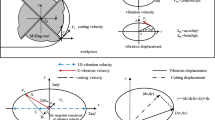Abstract
This study proposed a novel method to explain the reduction of cutting force in rotary ultrasonic vibration-assisted side milling (RUVSM) from the angle of tribology. Experiments, including practical machining and cutting simulation, were carried out to study the relationship among ultrasonic power, friction coefficient and cutting force. Specifically, cutting force and sonic signal were measured during machining and the cutting forces were calculated under different friction coefficients in the cutting simulation. Furthermore, an analytical method was developed to estimate the reduction of friction coefficient with ultrasonic vibration and further to predict the reduction of cutting force to some degree under different machining parameters. Specifically, the coulomb static model was introduced for the calculation and the vibration characteristics of the spiral milling tool were obtained by the finite element method (FEM).












Similar content being viewed by others

Data availability
The datasets supporting the results of this article are included within the article.
References
Singh RP, Singhal S (2016) Rotary ultrasonic machining: a review. Adv Manuf Process 31(14):1795–1824. https://doi.org/10.1080/10426914.2016.1140188
Wang H, Pei ZJ, Cong W (2020) A feeding-directional cutting force model for end surface grinding of CFRP composites using rotary ultrasonic machining with elliptical ultrasonic vibration. Int J Mach Tools Manuf 152:103540. https://doi.org/10.1016/j.ijmachtools.2020.103540
Eynian M (2015) Vibration frequencies in stable and unstable milling. Int J Mach Tools Manuf 90:44–49. https://doi.org/10.1016/j.ijmachtools.2014.12.004
Ning F, Cong W (2020) Ultrasonic vibration-assisted (UV-A) manufacturing processes: state of the art and future perspectives. J Manuf Process 51:174–190. https://doi.org/10.1016/j.jmapro.2020.01.028
Abootorabi Zarchi MM, Razfar MR, Abdullah A (2013) Influence of ultrasonic vibrations on side milling of AISI 420 stainless steel. Int J Adv Manuf Technol 66:83–89. https://doi.org/10.1007/s00170-012-4307-9
Li KM, Wang SL (2014) Effect of tool wear in ultrasonic vibration-assisted micro-milling. Proc Inst Mech Eng B J Eng Manuf 228:847–855. https://doi.org/10.1177/0954405413510514
Ren W, Xu J, Lin J, Yu Z, Yu P, Lian Z, Yu H (2019) Research on homogenization and surface morphology of Ti-6Al-4V alloy by longitudinal-torsional coupled ultrasonic vibration ball-end milling. Int J Adv Manuf Technol 104(5):1–13. https://doi.org/10.1007/s00170-019-03668-4
Ni C, Zhu L (2020) Investigation on machining characteristics of TC4 alloy by simultaneous application of ultrasonic vibration-assisted milling (UVAM) and economical-environmental MQL technology. J Mater Process Technol 278:116518. https://doi.org/10.1016/j.jmatprotec.2019.116518
Verma GC, Pandey PM (2018) Machining forces in ultrasonic-vibration assisted end milling. Ultrasonics. 94:350–363. https://doi.org/10.1016/j.ultras.2018.07.004
Verma G, Pandey P, Dixit U (2017) Modeling of static machining force in axial ultrasonic-vibration assisted milling considering acoustic softening. Int J Mech Sci 136:1–16. https://doi.org/10.1016/j.ijmecsci.2017.11.048
Wang Y, Gong H, Fang FZ, Ni H (2016) Kinematic view of the cutting mechanism of rotary ultrasonic machining by using spiral cutting tools. Int J Adv Manuf Technol 83:461–474. https://doi.org/10.1007/s00170-015-7549-5
Wu C, Chen S, Xiao C, Cheng K, Ding H (2019) Longitudinal–torsional ultrasonic vibration-assisted side milling process. Proc Inst Mech Eng C J Mech Eng Sci 233:3356–3363. https://doi.org/10.1177/0954406218819023
Altintas Y (2000) Manufacturing automation: metal cutting mechanics machine tool vibrations and CNC design. Cambridge University Press, New York
Ding H, Chen SJ, Cheng K (2010) Two-dimensional vibration-assisted micro end milling: cutting force modelling and machining process dynamics. Proc Inst Mech Eng B J Eng Manuf 1(12):1–9. https://doi.org/10.1243/09544054JEM1984
Armarego EJA, Whitfield RC (1984) Computer based modeling of popular machining operations for force and power predictions. CIRP Ann 34:65–69. https://doi.org/10.1016/S0007-8506(07)61725-9
San-Juan M, Martín Ó, Santos F (2010) Experimental study of friction from cutting forces in orthogonal milling. Int J Mach Tools Manuf 50:591–600. https://doi.org/10.1016/j.ijmachtools.2010.03.013
Jamshidi H, Nategh MJ (2013) Theoretical and experimental investigation of the frictional behavior of the tool–chip interface in ultrasonic-vibration assisted turning. Int J Mach Tools Manuf 65:1–7. https://doi.org/10.1016/j.ijmachtools.2012.09.004
Kumar VC, Hutchings IM (2004) Reduction of the sliding friction of metals by the application of longitudinal or transverse ultrasonic vibration. Tribol Int 37:833–840. https://doi.org/10.1016/j.triboint.2004.05.003
Wang P, Hongjian N, Wang R, Li Z, Wang Y (2016) Experimental investigation of the effect of in-plane vibrations on friction for different materials. Tribol Int 99:237–247. https://doi.org/10.1016/j.triboint.2016.03.021
Littmann W, Storck H, Wallaschek J (2001) Sliding friction in the presence of ultrasonic oscillations: superposition of longitudinal oscillations. Arch Appl Mech (Ingenieur Archiv) 71:549–554. https://doi.org/10.1007/s004190100160
Storck H, Littmann W, Wallaschek J, Mracek M (2002) The effect of friction reduction in presence of ultrasonic vibrations and its relevance to travelling wave ultrasonic motors. Ultrasonics. 40:379–383. https://doi.org/10.1016/S0041-624X(02)00126-9
Gutowski P, Leus M (2012) The effect of longitudinal tangential vibrations on friction and driving forces in sliding motion. Tribol Int 55:108–118. https://doi.org/10.1016/j.triboint.2012.05.023
Gutowski P, Leus M (2015) Computational model for friction force estimation in sliding motion at transverse tangential vibrations of elastic contact support. Tribol Int 90:455–462. https://doi.org/10.1016/j.triboint.2015.04.044
Peng G (2007) Experimental Investigation of Sound Signals During Machining Process, Master's Degree of Engineering, Shandong University
Chowdhury MA, Helali M (2008) The effect of amplitude of vibration on the coefficient of friction for different materials. Tribol Int 41:307–314. https://doi.org/10.1016/j.triboint.2007.08.005
Merchant, Eugene M (1945) Mechanics of the metal cutting process. I. Orthogonal cutting and a type 2 chip. J Appl Phys 16(5):267. https://doi.org/10.1063/1.1707586
Author information
Authors and Affiliations
Contributions
All authors contributed significantly to the work with the order provided.
Corresponding author
Ethics declarations
Consent for publication
All the authors have reached agreement for publication.
Conflict of interest
The authors declare no competing interests.
Additional information
Publisher’s note
Springer Nature remains neutral with regard to jurisdictional claims in published maps and institutional affiliations.
Rights and permissions
About this article
Cite this article
Sun, YJ., Gong, H., Wang, Y. et al. Tribological viewpoint of the cutting force in rotary ultrasonic vibration-assisted side milling (RUVSM). Int J Adv Manuf Technol 114, 2839–2848 (2021). https://doi.org/10.1007/s00170-021-06966-y
Received:
Accepted:
Published:
Issue Date:
DOI: https://doi.org/10.1007/s00170-021-06966-y



